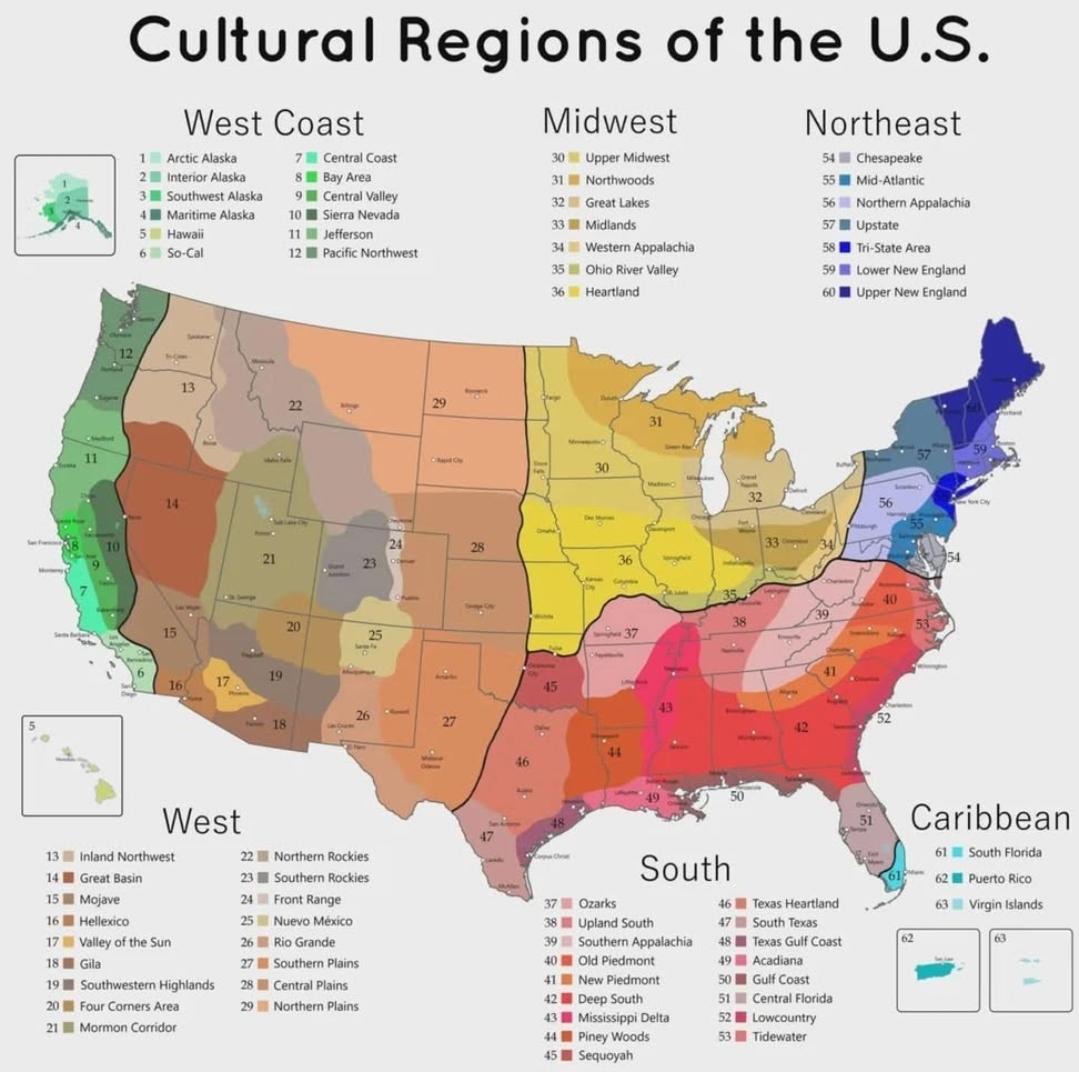Cultural Regions of America Map


David Chen
Data Visualization Specialist
David Chen is an expert in transforming complex geographic datasets into compelling visual narratives. He combines his background in computer science ...
Geographic Analysis
What This Map Shows
The "Cultural Regions of America Map" visually delineates the diverse cultural landscapes across the United States. It highlights how various factors, such as ethnicity, language, religion, and traditions, shape distinct cultural identities in different regions. This map serves as a powerful tool for understanding the rich tapestry of American society, where each area has its unique characteristics that contribute to the country's overall cultural richness.
Deep Dive into Cultural Regions
Cultural regions are defined by shared traits among their inhabitants, often stemming from historical migrations, settlement patterns, and social interactions. In the United States, these regions can be broadly categorized into several key areas: the Northeast, the South, the Midwest, the West, and the Pacific.
Interestingly, the Northeast is often seen as the cradle of American culture, where colonial history meets modern urban life. This region is characterized by its historical significance, a mix of old architecture, and a diverse population. Cities like New York and Boston showcase a melting pot of cultures, with significant immigrant populations contributing to the rich cultural fabric.
On the other hand, the South is known for its distinct cultural identity, heavily influenced by its history of agriculture and the legacy of the Civil War. Southern culture is often associated with hospitality, soul food, and the birthplace of blues and jazz music. The warmth of Southern traditions contrasts sharply with the more fast-paced lifestyle of Northeastern cities, illustrating how geography and history shape cultural expressions.
Moving to the Midwest, often referred to as the "heartland," this region is characterized by its agricultural roots and a strong sense of community. Midwesterners are known for their friendliness and a lifestyle focused on family and hard work. Cities like Chicago blend urban culture with a strong Midwestern identity, showcasing festivals that celebrate the region’s agricultural heritage.
In the West, the cultural landscape is defined by a mix of Native American heritage and influences from Asian and Hispanic cultures. The West has become synonymous with a spirit of adventure and innovation. The tech hubs of Silicon Valley and the artistic communities in places like Santa Fe highlight the region's diversity and forward-thinking mentality. Ever wondered why tech culture developed so rapidly in this area? The combination of education, immigration, and a pioneering spirit fuels this dynamic environment.
Lastly, the Pacific region is often seen as a cultural haven, influenced by the vast ocean and its connections to Asia. This area is home to a diverse population, including significant Asian American communities that have enriched the cultural landscape with their traditions, cuisine, and festivals. The cultural blend in cities like San Francisco and Los Angeles showcases the ongoing evolution of American culture.
Regional Analysis
Examining these cultural regions more closely reveals fascinating contrasts. For instance, the Northeast and the South have fundamentally different historical narratives that inform their current cultural identities. The Northeast may emphasize its colonial past and industrial development, while the South grapples with its legacy of slavery and civil rights struggles, shaping a culture deeply rooted in resilience and expression through music and art.
In the Midwest, the cultural identity is often expressed through agricultural fairs and community events, which stand in stark contrast to the tech-driven innovation found in the West. Interestingly, while the Midwest may lean more towards traditional values and lifestyles, the West embraces a more progressive outlook, heavily influenced by its diverse immigrant population. This cultural interplay shows how geography influences not just lifestyle but also values and social norms.
Significance and Impact
Understanding cultural regions in America is crucial for appreciating the complexity of its society. These regions inform everything from politics to social movements, economic trends, and even the arts. As the country becomes more interconnected, recognizing and respecting these cultural differences becomes more important than ever. Current trends, such as increased urbanization and globalization, are reshaping these cultural landscapes, leading to more hybrid identities and shared experiences.
Looking ahead, cultural regions will continue to evolve as migration patterns change and new generations emerge. Have you noticed how younger Americans are more likely to identify with multiple cultural influences? This trend suggests a future where cultural boundaries may blur, leading to an even richer and more diverse American identity. As we engage with these cultural regions, we not only celebrate our differences but also find common ground that unites us as a nation.
Visualization Details
- Published
- October 18, 2025
- Views
- 44
Comments
Loading comments...